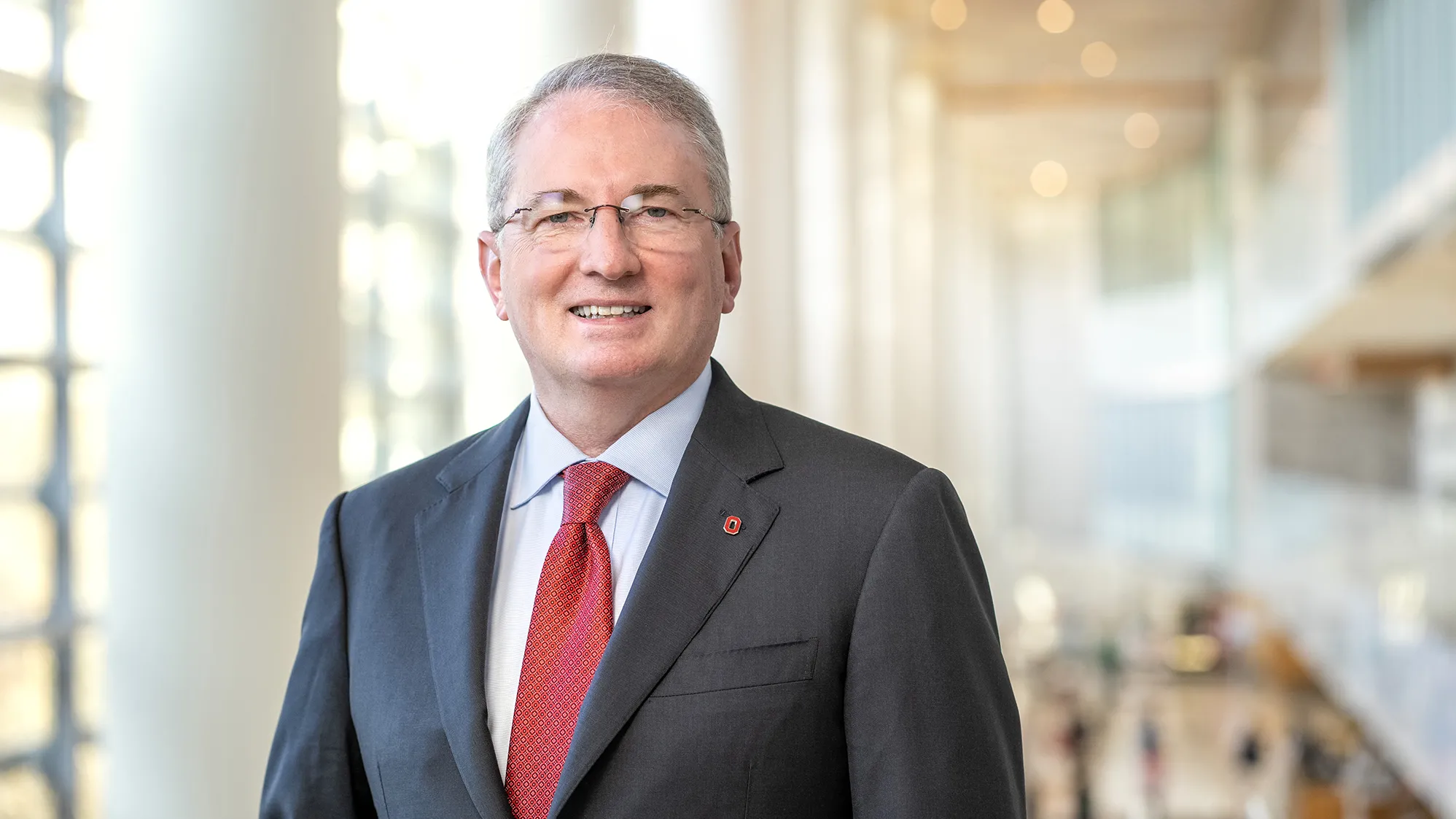Buckeye spirit is transforming health care in Ohio
With a determination to improve care, research and education, Dr. John J. Warner, the Wexner Medical Center’s CEO, sees bright days ahead.

Dr. John J. Warner became CEO of The Ohio State University Wexner Medical Center and university executive vice president in April 2023.
More than a year into his role as CEO of The Ohio State University Wexner Medical Center and executive vice president at Ohio State, Dr. John J. Warner is still impressed by the medical center’s extensive reach, the diverse populations it serves and its influence across the state and nation. “After listening and learning from the dedicated people around me, I’ve gained an understanding of what makes being a Buckeye so special,” Warner says.
He sees a lot on the horizon to be excited about, including Ohio State’s vision for transforming health care and its capacity to advance research, education and patient care. He recently took time to answer our questions and share more details with alumni.
-
What things in the last year made you most proud?
I admire the commitment, talent and teamwork that radiate from the people I work with daily. And the Buckeye family extends far beyond Central Ohio: The vast network around the globe helps feed this incredible spirit of collaboration at the Wexner Medical Center, the entire university and the broader communities we serve.
One of the things that makes our medical center so uniquely positioned to take on and solve industrywide challenges is our connection to this leading land-grant research university. We are the only major university with all seven health sciences colleges (Public Health, Medicine, Nursing, Veterinary Medicine, Dentistry, Pharmacy and Optometry) geographically adjacent to the central clinical campus. That proximity fuels our interdisciplinary collaboration and creates a powerhouse that will make Ohio State a leader in health care transformation.
It’s truly been an exciting year, and I’ve had the opportunity to be part of many milestone successes in just a short time. To name just a few, we’ve opened the Pelotonia Research Center, home to The James’ Pelotonia Institute for Immuno-Oncology; launched a partnership with Columbus State to train additional surgical technologists and create a pipeline to help grow our workforce; celebrated the grand opening of our new Healthy Community Center on the Near East Side of Columbus; and welcomed students to our new Hamilton Hall. Home to our College of Medicine, it will serve as a hub for interdisciplinary learning and collaboration across the health sciences colleges.
Also coming to mind are a few standout examples of true collaboration that represent our commitment to providing the highest quality of care: This year, we launched the State of Ohio Adversity and Resilience (SOAR) Study, for which we’re taking on the challenge of unraveling the complexities of mental illness and addiction to create solutions. There’s never been a research effort of this scale on mental health, addiction and resilience.
In collaboration with Nationwide Children’s Hospital, we also opened The James Outpatient Care in Ohio State’s new Carmenton innovation district to expand our cancer research. This new facility brings advanced cancer care to an outpatient setting, making it easier for more patients, including pediatric patients, to access the nationally recognized care offered at The Ohio State University Comprehensive Cancer Center–Arthur G. James Cancer Hospital and Richard J. Solove Research Institute. It houses some highly advanced technology, including the region’s only proton therapy center.
-
What are some things on the horizon that you are most excited about?
Above all, I’m so proud of the work that is being done to prepare for the opening of our new inpatient tower—the largest single facilities project ever undertaken at Ohio State. It’s the embodiment of the education and research we do here, to provide the best patient care possible.
The new hospital tower will give our patients unparalleled care in a state-of-the-art facility that delivers our nationally ranked expertise and the innovative breakthroughs we’re known for. The tower reflects our land-grant mission of serving the community by providing the best care for every person, every time, regardless of background.
This 26-story, state-of-the-art facility is set to open in 2026. It will give our clinicians, researchers and staff the resources and environment to raise the bar for leading-edge research, outstanding clinical training and world-class patient care. Every detail of our new tower was strategically planned to emphasize collaborations that improve care and create the very best possible experience for patients and staff alike.

Tower facts
The new hospital tower, by the numbers
1.9 million square feet
410 feet tall (the 10th tallest building in Columbus)
24 patient floors
820 private rooms
234 ICU beds
51 NICU bassinets
24 operating rooms
10 interventional radiology suites
-
Are there any real-life examples of innovation at work that will be seen in the new tower?
At the Wexner Medical Center, there’s a real appetite for finding new ways to improve lives, and we are proud to be at the forefront of innovation, research and education. Being part of Ohio State means we can use leading-edge technology and innovation to quickly translate biomedical research advancements into treatments and therapies that improve care.
One of the innovative technologies we’ve begun using in our operating rooms is augmented reality (AR), which allows surgeons to see their work in greater detail and make smaller incisions. In one spine surgery, AR glasses were used to provide a high-definition image of the spine. The AR glasses show a computerized tomography (CT) scan of the patient’s spine, allowing the surgeons to see the spinal architecture and place the screws and cages more precisely and with a significant time reduction. The new tower will be fully equipped to support advancements in technologies like this so that our patients and their families can count on us for the very best care and outcomes.
It’s also designed with patients in mind and will offer the latest telehealth technologies, video conferencing, environmental room controls, patient care team information, educational materials and entertainment via a 75-inch digital footwall installed across from the bed.
Our new inpatient tower is not just a building, but a symbol of our commitment to advancing health care and transforming lives.
-
How are you guiding the medical center to prepare for changes across the health care industry?
Health care delivery is undergoing a major transformation. I predict it’s set to change more in the next 10 years than it has in the last 50, and that’s really exciting to be part of. I believed when I took on this role—and I’m even more convinced now—that the Wexner Medical Center has all the right resources and talent to not just be part of the transformation but to lead it.
One of the things I’m most passionate about is creating a health care system that’s easier to manage, both for patients and caregivers. That means focusing on expanding access to care as well as improving ease of navigation, while still improving patient outcomes.
As we’re mapping our vision that will guide our work for the next decade, we have a unique opportunity to further enhance the collaborations of the three-part academic medicine mission happening at Ohio State—advancing research, education and patient care.
-
According to the Mid-Ohio Regional Planning Commission, Central Ohio’s population will exceed 3 million by 2050. What opportunities does this create for health systems, and specifically The Ohio State University Wexner Medical Center?
We are dedicated to meeting the health care needs of all Ohioans. That will be especially true as we expand our reach and impact across Columbus, as well as throughout Ohio, to keep pace with the influx in population. We are equally committed to leading the transformation of the health care delivery model to one that exceeds both the needs and the expectations that people have of their health care experience.
To achieve this goal, we’re focused on purposeful growth, like expanding our outpatient care network, bringing our world-class care to more communities across the state and beyond. We’ll also enhance our digital health platforms, using technology to empower our patients to access and manage their care with ease and at their convenience. We’ll improve our patient navigation and coordination services, and we’ll continue investing in growing and developing our workforce to ensure we have the talent, skills and passion to make our vision for the future a reality.
More to the tower’s story
Opening in 2026, Wexner Medical Center’s new inpatient tower is designed to deliver unrivaled care in a state-of-the-art hospital. On its website, you can see more views of the tower and dig into more details.


